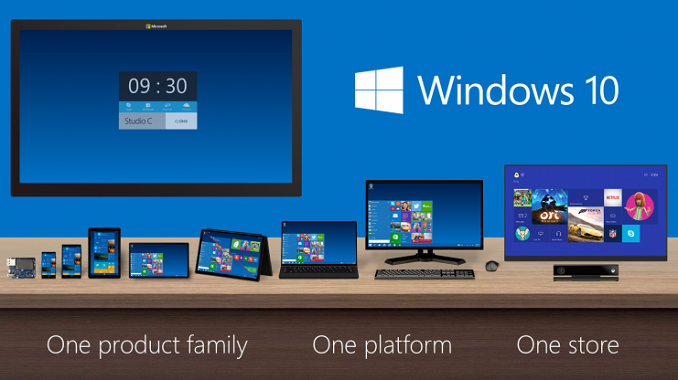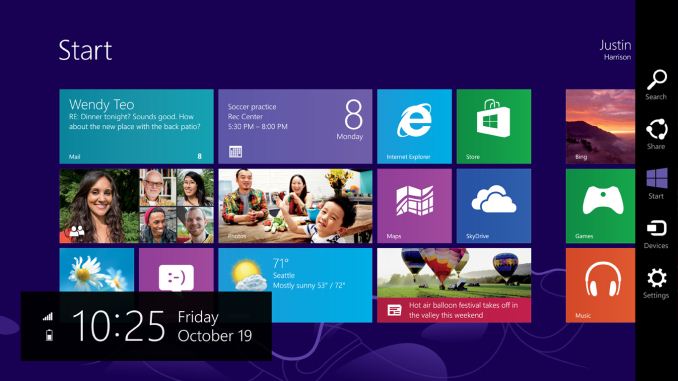Windows 10 Technical Preview First Impressions: The Return Of The Desktop
by Brett Howse on November 13, 2014 8:00 AM EST- Posted in
- Software
- Microsoft
- Windows 10

I’ve said this before, and I will reiterate it now. Windows 8, in general, is not perceived in a positive light. Not necessarily because of the lack of features, or even due to the touch first interface, but because from the start people did not buy into the paradigm. We can argue over why that was, and the specifics are likely different for every individual. But a big part of that was that Windows, which has had a familiar interface since Windows 95, had changed dramatically in look, feel, and general use. The traditional mouse and keyboard PC and notebook is a big part of the Windows user base, and especially at the beginning, Windows 8 did not cater to that crowd. While there were certainly improvements to the desktop, it was not enough to overcome the negative feelings of many users in regards to being productive on their PC. I say this as a fan of Windows 8.1, and I say this despite the positive review from this site. Windows 8 was an OS that worked, but had a steep learning curve that many people did not want to bother learning.
One of the biggest issues facing Windows 8 was just how much people liked Windows 7. Windows 7 was seen as the savior to Vista, and fixed many of its issues. But a lot of the initial problems with Vista were due to a major change in the driver model as well as the security model, which caused a lot of compatibility issues with older programs which expected administrator rights, as well as many hardware devices needed driver updates. With Windows 7, all of those changes were in the rear view mirror, allowing 7 to be a tweak of the overall UI and functionality rather than a rebuild of the OS from the ground up. With Windows 8, the move to touch first caused another dramatic upheaval. This time, rather than incompatible programs and hardware, we got a new Start Screen, a new runtime in WinRT, and a new app model with the Windows Store. For reasons that will never be made clear, the familiar start button was even removed, with the designers relying on hidden functions such as the hot corners to navigate around the OS with a mouse and keyboard. Luckily this change was reversed for Windows 8.1, with the start button returning, even if it still opened the Start Screen. With the Windows 8.1 Update, the system was made much more usable for a mouse and keyboard with the return of the menu bar to close apps, rather than dragging them down off the screen, and several other changes as well which brought the balance back somewhat to cover both touch interfaces as well as the mouse and keyboard.
 Windows 8 at launch in October 2012
Windows 8 at launch in October 2012
With Windows 8, Microsoft tried out an operating system which would work with a single interface across a breadth of hardware, from small form factor tablets, up to 30” monitor desktops. While they certainly succeeded in creating an interface that worked across all of those platforms, it was not ideally suited to any of them. With the tablet mode, the new Start Screen worked very well, and the charms menu and app switcher were fairly easy to use. But many of the settings and programs would be on the desktop, where touch only worked sparingly. Some desktop applications, such as Office, were created with a touch mode to increase the size of the onscreen elements, but overall the experience was subpar. Similarly, on the desktop, the touch interfaces were not ideal, and the hot corners certainly had issues especially on multi-monitor systems.
Windows 10 Technical Preview at launch
But now we come to Windows 10. Windows 10 is ditching the “One Interface to Rule them All” mentality, and moving to a more user friendly model of a single store across all platforms, and multiple interfaces to the same OS depending on the current usage model. We have not seen all of this in practice as of yet in the Technical Preview, but Microsoft has demonstrated their solution to this change in input mode with a feature they are calling Continuum.
The goal is that those that are on a keyboard and mouse based system will have the traditional start menu and desktop, with apps in windows, but if you are on a touch based device, or if you go on a 2-in-1 from keyboard to touch, the system will switch to the Windows 8 style start screen with full screen apps.
One of the keys to having this experience is an app model that allows a developer to target this different user interface paradigms. Microsoft’s solution to this is Universal Apps.











198 Comments
View All Comments
darthrevan13 - Thursday, November 13, 2014 - link
Windows Experience Index is still in Windows 8, it just does not have an interface. You can rate your computer through Power Shell if you want it so badly.calculagator - Thursday, November 13, 2014 - link
Windows 8.1 (and 8?) still has the Experience Index and the GUI: It's called "Performance Information and Tools." I think the numbers go higher than in Windows 7, but it's basically the same thing.TeXWiller - Saturday, November 15, 2014 - link
The familiar index can be generated with WinSAT.exe. It apparently optimizes the system in other ways as well since after installing or trasferring the system on an SSD one should run the formal assessment (winsat formal) to minimize writes.therightclique - Monday, November 17, 2014 - link
If there's a GUI, I can't find it, nor does there seem to be any information on it online. The only way to run it in 8.1 seems to be via command line.ryrynz - Tuesday, November 18, 2014 - link
It doesn't have one, grab thishttp://win-experience-index.chris-pc.com/
It's a WEI gui, though TBH I like Passmark's PerformanceTest more as a benchmark.. WEI is kinda shit.
BedfordTim - Thursday, November 13, 2014 - link
The difficulty is they need to try ideas out and some will fail. To leave the failures in means the OS becomes unmanageable.They have more of an issue with APIs, which do tend to live on. I am not sure how many different ways there are of dealing with strings and images, but the number is huge and most of them come in to the mistake category. They have deprecated some disasters such as DirectShow, and yet they live on in a dreadful limbo where the header files are missing and yet the DLLs work and no replacement has arrived.
mkozakewich - Thursday, November 13, 2014 - link
The problem with that is they force you to use those features and become familiar with them before they take them out. I had to work around Libraries for a while, until I found out I could just move them from My Documents. I also delete the "Libraries" section from my Explorer sidebar and put them into the favourites. In short, I've made it work for me. The more the abstract these things away, the less I'll be able to move them around. I'm afraid we'll end up with mobile-style Video dumps, where every video on all my drives will be crammed together in one single unsorted view.damianrobertjones - Thursday, November 13, 2014 - link
" force you to use those features"No-one has ever forced me to use Windows or a feature of windows. Ever.
therightclique - Monday, November 17, 2014 - link
Well, that may be true, but they do force them to be in your way when you're trying to do things the way they used to be.taltamir - Monday, December 29, 2014 - link
That didn't stop them from TRYING to force users to do things their ways. users said no (see win8 abysmal adoption rate)